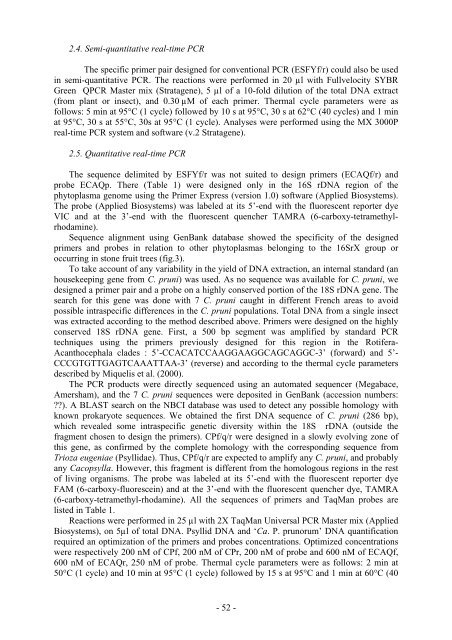Ecole Nationale Supérieure Agronomique de Montpellier ... - CIAM
Ecole Nationale Supérieure Agronomique de Montpellier ... - CIAM
Ecole Nationale Supérieure Agronomique de Montpellier ... - CIAM
Create successful ePaper yourself
Turn your PDF publications into a flip-book with our unique Google optimized e-Paper software.
2.4. Semi-quantitative real-time PCR<br />
The specific primer pair <strong>de</strong>signed for conventional PCR (ESFYf/r) could also be used<br />
in semi-quantitative PCR. The reactions were performed in 20 µl with Fullvelocity SYBR<br />
Green QPCR Master mix (Stratagene), 5 µl of a 10-fold dilution of the total DNA extract<br />
(from plant or insect), and 0.30 µM of each primer. Thermal cycle parameters were as<br />
follows: 5 min at 95°C (1 cycle) followed by 10 s at 95°C, 30 s at 62°C (40 cycles) and 1 min<br />
at 95°C, 30 s at 55°C, 30s at 95°C (1 cycle). Analyses were performed using the MX 3000P<br />
real-time PCR system and software (v.2 Stratagene).<br />
2.5. Quantitative real-time PCR<br />
The sequence <strong>de</strong>limited by ESFYf/r was not suited to <strong>de</strong>sign primers (ECAQf/r) and<br />
probe ECAQp. There (Table 1) were <strong>de</strong>signed only in the 16S rDNA region of the<br />
phytoplasma genome using the Primer Express (version 1.0) software (Applied Biosystems).<br />
The probe (Applied Biosystems) was labeled at its 5’-end with the fluorescent reporter dye<br />
VIC and at the 3’-end with the fluorescent quencher TAMRA (6-carboxy-tetramethylrhodamine).<br />
Sequence alignment using GenBank database showed the specificity of the <strong>de</strong>signed<br />
primers and probes in relation to other phytoplasmas belonging to the 16SrX group or<br />
occurring in stone fruit trees (fig.3).<br />
To take account of any variability in the yield of DNA extraction, an internal standard (an<br />
housekeeping gene from C. pruni) was used. As no sequence was available for C. pruni, we<br />
<strong>de</strong>signed a primer pair and a probe on a highly conserved portion of the 18S rDNA gene. The<br />
search for this gene was done with 7 C. pruni caught in different French areas to avoid<br />
possible intraspecific differences in the C. pruni populations. Total DNA from a single insect<br />
was extracted according to the method <strong>de</strong>scribed above. Primers were <strong>de</strong>signed on the highly<br />
conserved 18S rDNA gene. First, a 500 bp segment was amplified by standard PCR<br />
techniques using the primers previously <strong>de</strong>signed for this region in the Rotifera-<br />
Acanthocephala cla<strong>de</strong>s : 5’-CCACATCCAAGGAAGGCAGCAGGC-3’ (forward) and 5’-<br />
CCCGTGTTGAGTCAAATTAA-3’ (reverse) and according to the thermal cycle parameters<br />
<strong>de</strong>scribed by Miquelis et al. (2000).<br />
The PCR products were directly sequenced using an automated sequencer (Megabace,<br />
Amersham), and the 7 C. pruni sequences were <strong>de</strong>posited in GenBank (accession numbers:<br />
??). A BLAST search on the NBCI database was used to <strong>de</strong>tect any possible homology with<br />
known prokaryote sequences. We obtained the first DNA sequence of C. pruni (286 bp),<br />
which revealed some intraspecific genetic diversity within the 18S rDNA (outsi<strong>de</strong> the<br />
fragment chosen to <strong>de</strong>sign the primers). CPf/q/r were <strong>de</strong>signed in a slowly evolving zone of<br />
this gene, as confirmed by the complete homology with the corresponding sequence from<br />
Trioza eugeniae (Psyllidae). Thus, CPf/q/r are expected to amplify any C. pruni, and probably<br />
any Cacopsylla. However, this fragment is different from the homologous regions in the rest<br />
of living organisms. The probe was labeled at its 5’-end with the fluorescent reporter dye<br />
FAM (6-carboxy-fluorescein) and at the 3’-end with the fluorescent quencher dye, TAMRA<br />
(6-carboxy-tetramethyl-rhodamine). All the sequences of primers and TaqMan probes are<br />
listed in Table 1.<br />
Reactions were performed in 25 µl with 2X TaqMan Universal PCR Master mix (Applied<br />
Biosystems), on 5µl of total DNA. Psyllid DNA and ‘Ca. P. prunorum’ DNA quantification<br />
required an optimization of the primers and probes concentrations. Optimized concentrations<br />
were respectively 200 nM of CPf, 200 nM of CPr, 200 nM of probe and 600 nM of ECAQf,<br />
600 nM of ECAQr, 250 nM of probe. Thermal cycle parameters were as follows: 2 min at<br />
50°C (1 cycle) and 10 min at 95°C (1 cycle) followed by 15 s at 95°C and 1 min at 60°C (40<br />
- 52 -



